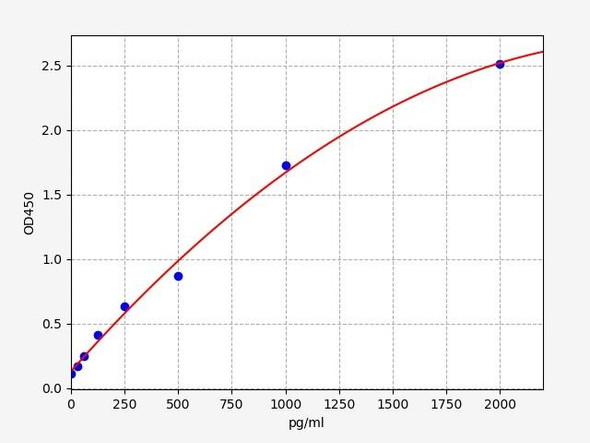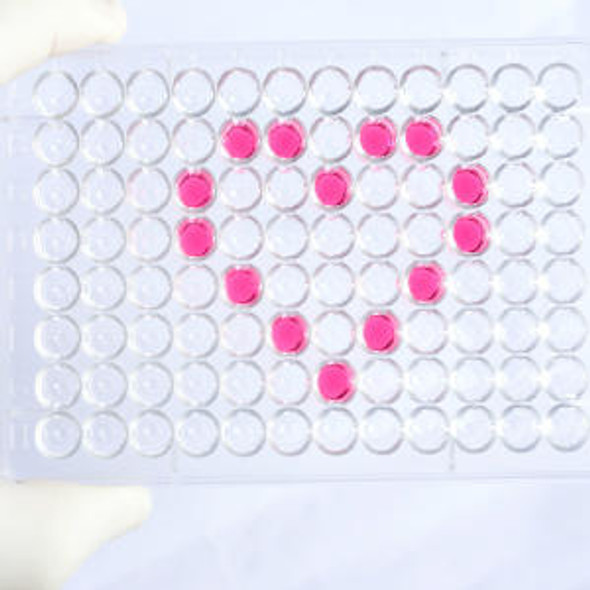Human Transcription initiation factor TFIID subunit 1 (TAF1) ELISA Kit
- SKU:
- HUEB2561
- Product Type:
- ELISA Kit
- Size:
- 96 Assays
- Uniprot:
- P21675
- Range:
- 0.312-20 ng/mL
- ELISA Type:
- Sandwich
- Reactivity:
- Human
Description
| Product Name: | Human Transcription initiation factor TFIID subunit 1 (TAF1) ELISA Kit |
| Product Code: | HUEB2561 |
| Alias: | Transcription initiation factor TFIID subunit 1, Cell cycle gene 1 protein, TBP-associated factor 250 kDa, p250, Transcription initiation factor TFIID 250 kDa subunit, TAF(II)250, TAFII-250, TAFII250, TAF1, BA2R, CCG1, CCGS, TAF2A, 2.7.11.1 |
| Uniprot: | P21675 |
| Reactivity: | Human |
| Range: | 0.312-20 ng/mL |
| Detection Method: | Sandwich |
| Size: | 96 Assay |
| Storage: | Please see kit components below for exact storage details |
| Note: | For research use only |
| UniProt Protein Function: | TAF1: Largest component and core scaffold of the TFIID basal transcription factor complex. Contains novel N- and C-terminal Ser/Thr kinase domains which can autophosphorylate or transphosphorylate other transcription factors. Phosphorylates TP53 on 'Thr-55' which leads to MDM2-mediated degradation of TP53. Phosphorylates GTF2A1 and GTF2F1 on Ser residues. Possesses DNA- binding activity. Essential for progression of the G1 phase of the cell cycle. Defects in TAF1 are the cause of dystonia type 3 (DYT3); also called X-linked dystonia-parkinsonism (XDP). DYT3 is a X-linked dystonia-parkinsonism disorder. Dystonia is defined by the presence of sustained involuntary muscle contractions, often leading to abnormal postures. DYT3 is characterized by severe progressive torsion dystonia followed by parkinsonism. Its prevalence is high in the Philippines. DYT3 has a well-defined pathology of extensive neuronal loss and mosaic gliosis in the striatum (caudate nucleus and putamen) which appears to resemble that in Huntington disease. Belongs to the TAF1 family. 4 isoforms of the human protein are produced by alternative splicing. |
| UniProt Protein Details: | Protein type:Kinase, protein; Protein kinase, atypical; EC 2.7.11.1; DNA-binding; Transcription, coactivator/corepressor; EC 2.3.1.48; Protein kinase, Ser/Thr (non-receptor); ATYPICAL group; TAF1 family Chromosomal Location of Human Ortholog: Xq13.1 Cellular Component: nucleoplasm; transcription factor TFIID complex Molecular Function:histone acetyltransferase activity; p53 binding; protein binding; protein serine/threonine kinase activity; sequence-specific DNA binding; TATA-binding protein binding; transcription coactivator activity; transcription factor binding Biological Process: peptidyl-serine phosphorylation; peptidyl-threonine phosphorylation; positive regulation of proteasomal ubiquitin-dependent protein catabolic process; positive regulation of transcription from RNA polymerase II promoter; protein amino acid autophosphorylation; response to DNA damage stimulus; RNA elongation from RNA polymerase II promoter; transcription from RNA polymerase II promoter; transcription initiation; transcription initiation from RNA polymerase II promoter; transcriptional preinitiation complex assembly Disease: Dystonia 3, Torsion, X-linked |
| NCBI Summary: | Initiation of transcription by RNA polymerase II requires the activities of more than 70 polypeptides. The protein that coordinates these activities is the basal transcription factor TFIID, which binds to the core promoter to position the polymerase properly, serves as the scaffold for assembly of the remainder of the transcription complex, and acts as a channel for regulatory signals. TFIID is composed of the TATA-binding protein (TBP) and a group of evolutionarily conserved proteins known as TBP-associated factors or TAFs. TAFs may participate in basal transcription, serve as coactivators, function in promoter recognition or modify general transcription factors (GTFs) to facilitate complex assembly and transcription initiation. This gene encodes the largest subunit of TFIID. This subunit binds to core promoter sequences encompassing the transcription start site. It also binds to activators and other transcriptional regulators, and these interactions affect the rate of transcription initiation. This subunit contains two independent protein kinase domains at the N- and C-terminals, but also possesses acetyltransferase activity and can act as a ubiquitin-activating/conjugating enzyme. Mutations in this gene result in Dystonia 3, torsion, X-linked, a dystonia-parkinsonism disorder. Alternative splicing of this gene results in multiple transcript variants. This gene is part of a complex transcription unit (TAF1/DYT3), wherein some transcript variants share exons with TAF1 as well as additional downstream DYT3 exons. [provided by RefSeq, Oct 2013] |
| UniProt Code: | P21675 |
| NCBI GenInfo Identifier: | 115942 |
| NCBI Gene ID: | 6872 |
| NCBI Accession: | P21675.2 |
| UniProt Secondary Accession: | P21675,Q59FZ3, Q6IUZ1, Q70Q86, Q70Q87, Q70T00, Q70T01 A5CVC8, A5CVC9, A5CVD0, A5CVD1, B1Q2X3, |
| UniProt Related Accession: | P21675 |
| Molecular Weight: | 214,913 Da |
| NCBI Full Name: | Transcription initiation factor TFIID subunit 1 |
| NCBI Synonym Full Names: | TATA-box binding protein associated factor 1 |
| NCBI Official Symbol: | TAF1 |
| NCBI Official Synonym Symbols: | OF; XDP; BA2R; CCG1; CCGS; DYT3; KAT4; P250; NSCL2; TAF2A; MRXS33; N-TAF1; TAFII250; DYT3/TAF1; TAFII-250; TAF(II)250 |
| NCBI Protein Information: | transcription initiation factor TFIID subunit 1 |
| UniProt Protein Name: | Transcription initiation factor TFIID subunit 1 |
| UniProt Synonym Protein Names: | Cell cycle gene 1 protein; TBP-associated factor 250 kDa; p250; Transcription initiation factor TFIID 250 kDa subunit; TAF(II)250; TAFII-250; TAFII250 |
| Protein Family: | Taz1-interacting factor |
| UniProt Gene Name: | TAF1 |
| UniProt Entry Name: | TAF1_HUMAN |
| Component | Quantity (96 Assays) | Storage |
| ELISA Microplate (Dismountable) | 8×12 strips | -20°C |
| Lyophilized Standard | 2 | -20°C |
| Sample Diluent | 20ml | -20°C |
| Assay Diluent A | 10mL | -20°C |
| Assay Diluent B | 10mL | -20°C |
| Detection Reagent A | 120µL | -20°C |
| Detection Reagent B | 120µL | -20°C |
| Wash Buffer | 30mL | 4°C |
| Substrate | 10mL | 4°C |
| Stop Solution | 10mL | 4°C |
| Plate Sealer | 5 | - |
Other materials and equipment required:
- Microplate reader with 450 nm wavelength filter
- Multichannel Pipette, Pipette, microcentrifuge tubes and disposable pipette tips
- Incubator
- Deionized or distilled water
- Absorbent paper
- Buffer resevoir
*Note: The below protocol is a sample protocol. Protocols are specific to each batch/lot. For the correct instructions please follow the protocol included in your kit.
Allow all reagents to reach room temperature (Please do not dissolve the reagents at 37°C directly). All the reagents should be mixed thoroughly by gently swirling before pipetting. Avoid foaming. Keep appropriate numbers of strips for 1 experiment and remove extra strips from microtiter plate. Removed strips should be resealed and stored at -20°C until the kits expiry date. Prepare all reagents, working standards and samples as directed in the previous sections. Please predict the concentration before assaying. If values for these are not within the range of the standard curve, users must determine the optimal sample dilutions for their experiments. We recommend running all samples in duplicate.
| Step | |
| 1. | Add Sample: Add 100µL of Standard, Blank, or Sample per well. The blank well is added with Sample diluent. Solutions are added to the bottom of micro ELISA plate well, avoid inside wall touching and foaming as possible. Mix it gently. Cover the plate with sealer we provided. Incubate for 120 minutes at 37°C. |
| 2. | Remove the liquid from each well, don't wash. Add 100µL of Detection Reagent A working solution to each well. Cover with the Plate sealer. Gently tap the plate to ensure thorough mixing. Incubate for 1 hour at 37°C. Note: if Detection Reagent A appears cloudy warm to room temperature until solution is uniform. |
| 3. | Aspirate each well and wash, repeating the process three times. Wash by filling each well with Wash Buffer (approximately 400µL) (a squirt bottle, multi-channel pipette,manifold dispenser or automated washer are needed). Complete removal of liquid at each step is essential. After the last wash, completely remove remaining Wash Buffer by aspirating or decanting. Invert the plate and pat it against thick clean absorbent paper. |
| 4. | Add 100µL of Detection Reagent B working solution to each well. Cover with the Plate sealer. Incubate for 60 minutes at 37°C. |
| 5. | Repeat the wash process for five times as conducted in step 3. |
| 6. | Add 90µL of Substrate Solution to each well. Cover with a new Plate sealer and incubate for 10-20 minutes at 37°C. Protect the plate from light. The reaction time can be shortened or extended according to the actual color change, but this should not exceed more than 30 minutes. When apparent gradient appears in standard wells, user should terminatethe reaction. |
| 7. | Add 50µL of Stop Solution to each well. If color change does not appear uniform, gently tap the plate to ensure thorough mixing. |
| 8. | Determine the optical density (OD value) of each well at once, using a micro-plate reader set to 450 nm. User should open the micro-plate reader in advance, preheat the instrument, and set the testing parameters. |
| 9. | After experiment, store all reagents according to the specified storage temperature respectively until their expiry. |
When carrying out an ELISA assay it is important to prepare your samples in order to achieve the best possible results. Below we have a list of procedures for the preparation of samples for different sample types.
| Sample Type | Protocol |
| Serum | If using serum separator tubes, allow samples to clot for 30 minutes at room temperature. Centrifuge for 10 minutes at 1,000x g. Collect the serum fraction and assay promptly or aliquot and store the samples at -80°C. Avoid multiple freeze-thaw cycles. If serum separator tubes are not being used, allow samples to clot overnight at 2-8°C. Centrifuge for 10 minutes at 1,000x g. Remove serum and assay promptly or aliquot and store the samples at -80°C. Avoid multiple freeze-thaw cycles. |
| Plasma | Collect plasma using EDTA or heparin as an anticoagulant. Centrifuge samples at 4°C for 15 mins at 1000 × g within 30 mins of collection. Collect the plasma fraction and assay promptly or aliquot and store the samples at -80°C. Avoid multiple freeze-thaw cycles. Note: Over haemolysed samples are not suitable for use with this kit. |
| Urine & Cerebrospinal Fluid | Collect the urine (mid-stream) in a sterile container, centrifuge for 20 mins at 2000-3000 rpm. Remove supernatant and assay immediately. If any precipitation is detected, repeat the centrifugation step. A similar protocol can be used for cerebrospinal fluid. |
| Cell culture supernatant | Collect the cell culture media by pipette, followed by centrifugation at 4°C for 20 mins at 1500 rpm. Collect the clear supernatant and assay immediately. |
| Cell lysates | Solubilize cells in lysis buffer and allow to sit on ice for 30 minutes. Centrifuge tubes at 14,000 x g for 5 minutes to remove insoluble material. Aliquot the supernatant into a new tube and discard the remaining whole cell extract. Quantify total protein concentration using a total protein assay. Assay immediately or aliquot and store at ≤ -20 °C. |
| Tissue homogenates | The preparation of tissue homogenates will vary depending upon tissue type. Rinse tissue with 1X PBS to remove excess blood & homogenize in 20ml of 1X PBS (including protease inhibitors) and store overnight at ≤ -20°C. Two freeze-thaw cycles are required to break the cell membranes. To further disrupt the cell membranes you can sonicate the samples. Centrifuge homogenates for 5 mins at 5000xg. Remove the supernatant and assay immediately or aliquot and store at -20°C or -80°C. |
| Tissue lysates | Rinse tissue with PBS, cut into 1-2 mm pieces, and homogenize with a tissue homogenizer in PBS. Add an equal volume of RIPA buffer containing protease inhibitors and lyse tissues at room temperature for 30 minutes with gentle agitation. Centrifuge to remove debris. Quantify total protein concentration using a total protein assay. Assay immediately or aliquot and store at ≤ -20 °C. |
| Breast Milk | Collect milk samples and centrifuge at 10,000 x g for 60 min at 4°C. Aliquot the supernatant and assay. For long term use, store samples at -80°C. Minimize freeze/thaw cycles. |










